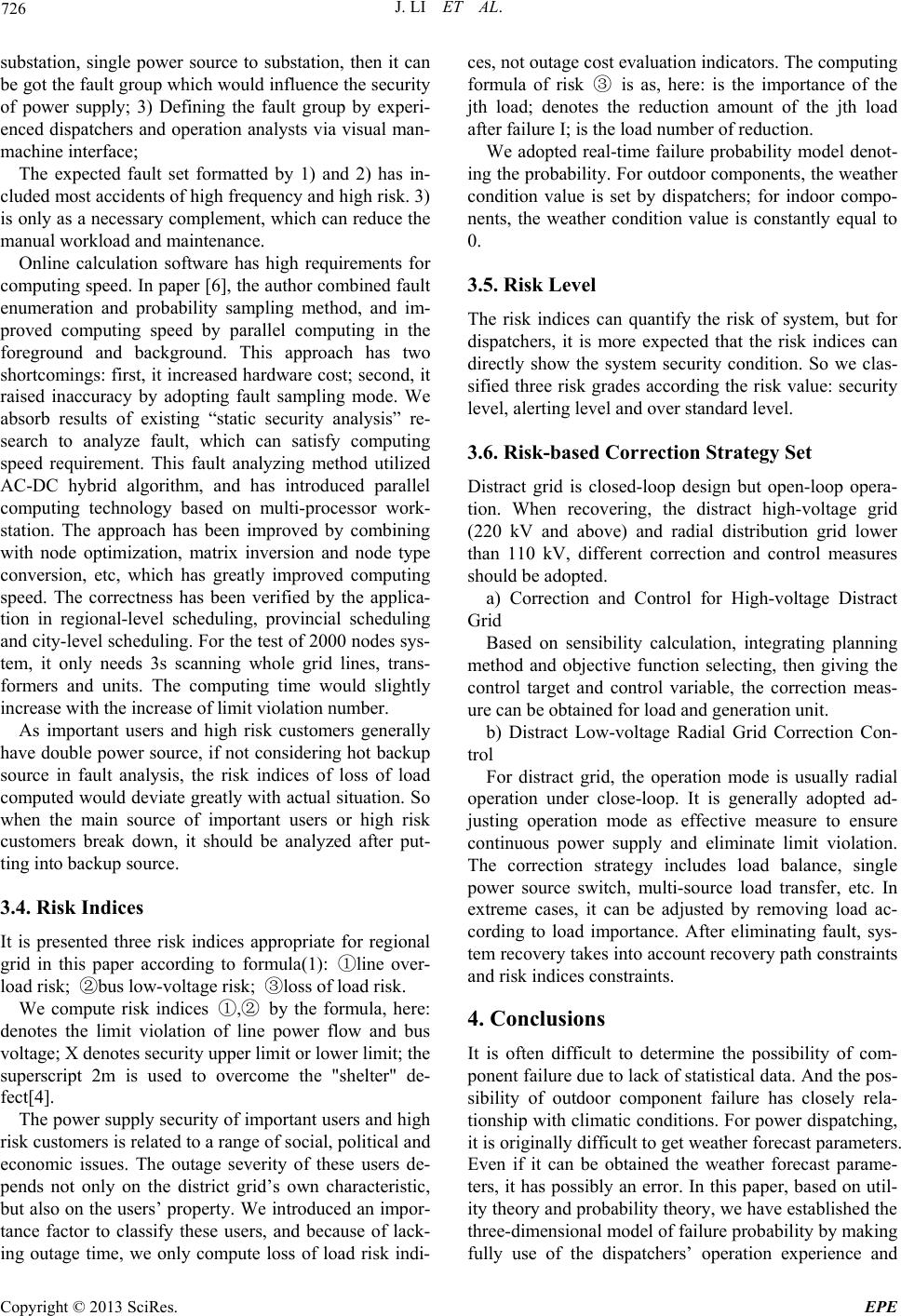
J. LI ET AL.
726
substation, single power source to substation, then it can
be got the fault group which would influence the security
of power supply; 3) Defining the fault group by experi-
enced dispatchers and operation analysts via visual man-
machine interface;
The expected fault set formatted by 1) and 2) has in-
cl
requirements for
co
ally
ha
3.4. Risk Indices
risk indices appropriate for regional
:
de
upply security of important users and high
ris
in
3.5. Risk Level
an quantify the risk of system, but for
3.6. Risk-based Correction Strategy Set
op opera-
d Control for High-voltage Distract
G
ed on sensibility calculation, integrating planning
m
n Con-
tro
r distract grid, the operation mode is usually radial
op
4. Conclusions
to determine the possibility of com-
uded most accidents of high frequency and high risk. 3)
is only as a necessary complement, which can reduce the
manual workload and maintenance.
Online calculation software has high
mputing speed. In paper [6], the author combined fault
enumeration and probability sampling method, and im-
proved computing speed by parallel computing in the
foreground and background. This approach has two
shortcomings: first, it increased hardware cost; second, it
raised inaccuracy by adopting fault sampling mode. We
absorb results of existing “static security analysis” re-
search to analyze fault, which can satisfy computing
speed requirement. This fault analyzing method utilized
AC-DC hybrid algorithm, and has introduced parallel
computing technology based on multi-processor work-
station. The approach has been improved by combining
with node optimization, matrix inversion and node type
conversion, etc, which has greatly improved computing
speed. The correctness has been verified by the applica-
tion in regional-level scheduling, provincial scheduling
and city-level scheduling. For the test of 2000 nodes sys-
tem, it only needs 3s scanning whole grid lines, trans-
formers and units. The computing time would slightly
increase with the increase of limit violation number.
As important users and high risk customers gener
ve double power source, if not considering hot backup
source in fault analysis, the risk indices of loss of load
computed would deviate greatly with actual situation. So
when the main source of important users or high risk
customers break down, it should be analyzed after put-
ting into backup source.
It is presented three
grid in this paper according to formula(1): ①line over-
load risk; ②bus low-voltage risk; ③loss of load risk.
We compute risk indices ①,② by the formula, here
notes the limit violation of line power flow and bus
voltage; X denotes security upper limit or lower limit; the
superscript 2m is used to overcome the "shelter" de-
fect[4].
The power s
k customers is related to a range of social, political and
economic issues. The outage severity of these users de-
pends not only on the district grid’s own characteristic,
but also on the users’ property. We introduced an impor-
tance factor to classify these users, and because of lack-
ing outage time, we only compute loss of load risk indi-
ces, not outage cost evaluation indicators. The computing
formula of risk ③ is as, here: is the importance of the
jth load; denotes the reduction amount of the jth load
after failure I; is the load number of reduction.
We adopted real-time failure probability model denot-
g the probability. For outdoor components, the weather
condition value is set by dispatchers; for indoor compo-
nents, the weather condition value is constantly equal to
0.
The risk indices c
dispatchers, it is more expected that the risk indices can
directly show the system security condition. So we clas-
sified three risk grades according the risk value: security
level, alerting level and over standard level.
Distract grid is closed-loop design but open-lo
tion. When recovering, the distract high-voltage grid
(220 kV and above) and radial distribution grid lower
than 110 kV, different correction and control measures
should be adopted.
a) Correction an
rid
Bas
ethod and objective function selecting, then giving the
control target and control variable, the correction meas-
ure can be obtained for load and generation unit.
b) Distract Low-voltage Radial Grid Correctio
l
Fo
eration under close-loop. It is generally adopted ad-
justing operation mode as effective measure to ensure
continuous power supply and eliminate limit violation.
The correction strategy includes load balance, single
power source switch, multi-source load transfer, etc. In
extreme cases, it can be adjusted by removing load ac-
cording to load importance. After eliminating fault, sys-
tem recovery takes into account recovery path constraints
and risk indices constraints.
It is often difficult
ponent failure due to lack of statistical data. And the pos-
sibility of outdoor component failure has closely rela-
tionship with climatic conditions. For power dispatching,
it is originally difficult to get weather forecast parameters.
Even if it can be obtained the weather forecast parame-
ters, it has possibly an error. In this paper, based on util-
ity theory and probability theory, we have established the
three-dimensional model of failure probability by making
fully use of the dispatchers’ operation experience and
Copyright © 2013 SciRes. EPE